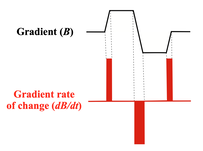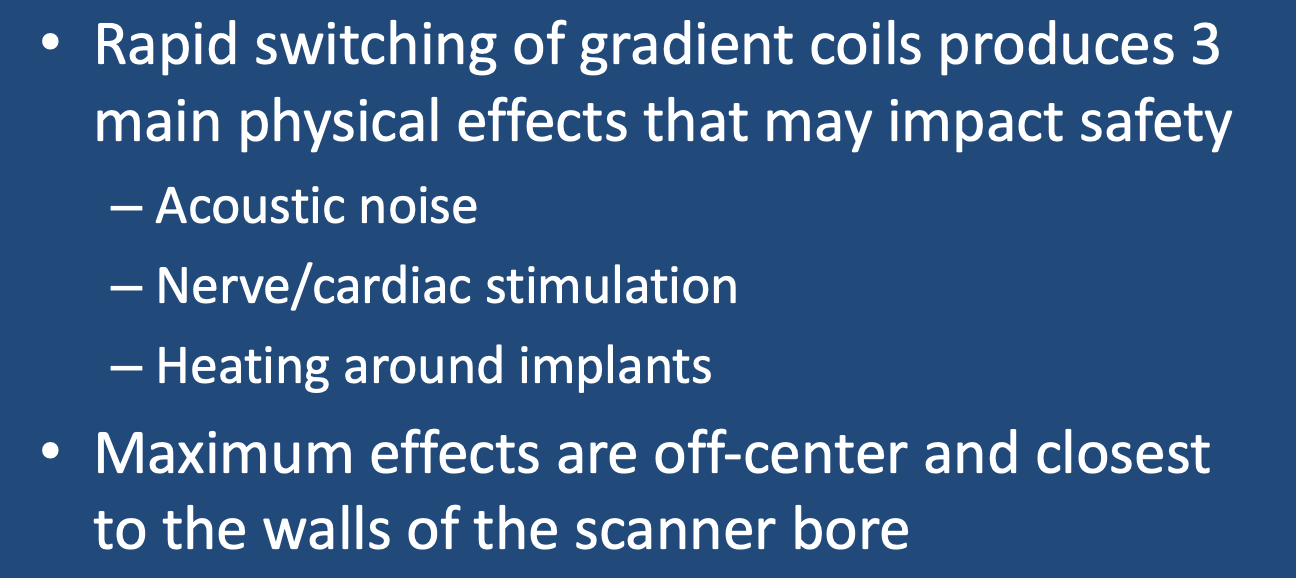As described in multiple prior Q&As, gradients are sets of electromagnets located behind the walls of MR scanners used for spatial encoding and signal generation. Gradients distort the main magnetic field in a predictable fashion, causing the resonance frequency of protons to vary as a function of position.
The strength of the magnetic fields generated by gradients are less than 3% of the main magnetic field (Bo), so their static effects are of no concern. Rather, it is the time rate of change of these gradient fields (dB/dt) that poses potential safety issues for MR imaging.
The strength of the magnetic fields generated by gradients are less than 3% of the main magnetic field (Bo), so their static effects are of no concern. Rather, it is the time rate of change of these gradient fields (dB/dt) that poses potential safety issues for MR imaging.
 Location of gradient coils and resultant dB/dt fields in a cylindrical scanner. Note there are two "hot spots" near the scanner walls about 30 cm on either side of isocenter. (Lower half of image courtesy of Dr. E. Kanal, created using the MagnetVision™ app he created)
Location of gradient coils and resultant dB/dt fields in a cylindrical scanner. Note there are two "hot spots" near the scanner walls about 30 cm on either side of isocenter. (Lower half of image courtesy of Dr. E. Kanal, created using the MagnetVision™ app he created)
A typical cylindrical MR scanner uses 3 sets of gradient coils, one set for each of the x-, y-, and z-directions. The gradients are typically thin wires or foil sheets in a "fingerprint"-type pattern held together by epoxy resin and encapsulated into an assembly that also incorporates cooling channels.
As shown in the illustration, the x- and y-gradient coils are arranged in pairs located on either side of isocenter. This arrangement means that the highest values of dB/dt are not located in the middle of the scanner, but eccentrically near the ceiling and walls, typically about ± 30 cm from isocenter (z = 0). The peak values of dB/dt next to the wall are about three times larger than those measured in the middle of the scanner at the same z-axis location.
As shown in the illustration, the x- and y-gradient coils are arranged in pairs located on either side of isocenter. This arrangement means that the highest values of dB/dt are not located in the middle of the scanner, but eccentrically near the ceiling and walls, typically about ± 30 cm from isocenter (z = 0). The peak values of dB/dt next to the wall are about three times larger than those measured in the middle of the scanner at the same z-axis location.
 Peak dB/dt values occur during gradient ramp up and ramp down periods.
Peak dB/dt values occur during gradient ramp up and ramp down periods.
Gradient coils are powered by high voltage/high current amplifiers located in an adjacent equipment room. Voltages of up to 1500V and currents of several hundred amperes are typical. In standard use the gradients are switched on and off quickly, with slew rates as high as 200 T/m/s. These rapidly changing currents flowing through the coils produce two major physical effects: a) mechanical vibration of the gradient system (and secondarily the scanner itself), and b) induced currents in nearby conductive materials proportional to dB/dt, the rate of change of the gradient field (a manifestation of Faraday's Law).
These physical effects of rapid current flows through the gradients give rise to three potential MR safety concerns discussed in subsequent Q&A's:
- Acoustic noise
- Nerve/cardiac stimulation
- Heating around implants
Advanced Discussion (show/hide)»
No supplementary material yet. Check back soon!
References
Hidalgo-Tabon SS. Theory of gradient coil design methods for magnetic resonance imaging. Concepts Mag Res Part A 2001; 36A:223-242.
Kanal E. Standardized approaches to MR safety assessment of patients with implanted devices. Magn Reson Imaging Clin N Am 2020; 28:537-548. [DOI LINK]
Schaefer DJ, Bourland JD, Nyenhuis JA. Review of patient safety in time-varying gradient fields. J Magn Reson Imaging 2000; 12:20-29. [DOI Link]
Stafford RJ. The physics of magnetic resonance imaging safety. Magn Reson Imaging Clin N Am 2020; 28:517-536. [DOI LINK]
Hidalgo-Tabon SS. Theory of gradient coil design methods for magnetic resonance imaging. Concepts Mag Res Part A 2001; 36A:223-242.
Kanal E. Standardized approaches to MR safety assessment of patients with implanted devices. Magn Reson Imaging Clin N Am 2020; 28:537-548. [DOI LINK]
Schaefer DJ, Bourland JD, Nyenhuis JA. Review of patient safety in time-varying gradient fields. J Magn Reson Imaging 2000; 12:20-29. [DOI Link]
Stafford RJ. The physics of magnetic resonance imaging safety. Magn Reson Imaging Clin N Am 2020; 28:517-536. [DOI LINK]
Related Questions
What are gradient coils?
The MR sales representative is telling me about his scanner's strong gradients. How do I interpret the specification sheet?
What are gradient coils?
The MR sales representative is telling me about his scanner's strong gradients. How do I interpret the specification sheet?
